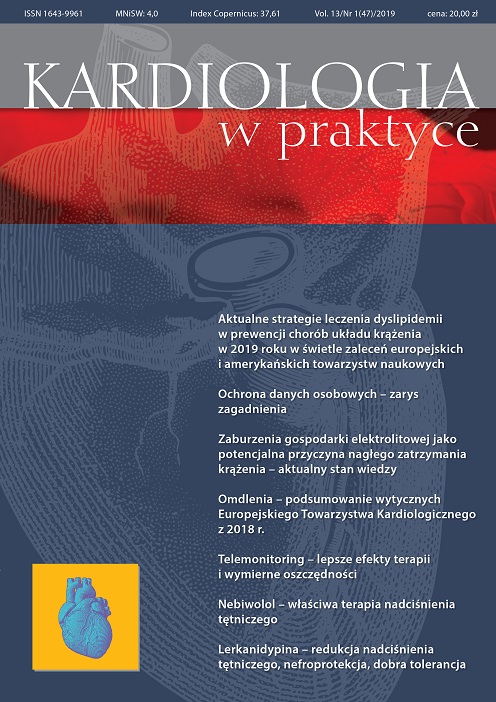Telemonitoring – lepsze efekty terapii i wymierne oszczędności Artykuł przeglądowy
##plugins.themes.bootstrap3.article.main##
Abstrakt
Z każdym rokiem rośnie liczba pacjentów z urządzeniami wszczepialnymi, a zatem populacja pacjentów wymagających regularnych kontroli. Zdalny monitoring umożliwia przesyłanie danych z urządzenia do serwerów centralnych i udostępnianie ich personelowi kardiologicznemu. Udowodniono, że jest on bezpieczny, opłacalny i poprawia opiekę nad chorymi.
Pobrania
##plugins.themes.bootstrap3.article.details##

Utwór dostępny jest na licencji Creative Commons Uznanie autorstwa – Użycie niekomercyjne 4.0 Międzynarodowe.
Copyright: © Medical Education sp. z o.o. This is an Open Access article distributed under the terms of the Attribution-NonCommercial 4.0 International (CC BY-NC 4.0). License (https://creativecommons.org/licenses/by-nc/4.0/), allowing third parties to copy and redistribute the material in any medium or format and to remix, transform, and build upon the material, provided the original work is properly cited and states its license.
Address reprint requests to: Medical Education, Marcin Kuźma (marcin.kuzma@mededu.pl)
Bibliografia
2. Dane GUS. Online: https://stat.gov.pl/.
3. Epstein A.E.: Benefits of the Implantable Cardioverter-Defibrillator. J. Am. Coll. Cardiol. 2008; 52: 1122-1117.
4. Bradley D.J., Bradley E.A., Baughman K.L. et al.: Cardiac resynchronization and death from progressive heart failure: a meta-analysis of randomized controlled trials. JAMA 2003; 289: 730-740.
5. Cleland J.G.F., Daubert J.C., Erdmann E. et al.: The Effect of Cardiac Resynchronization on Morbidity and Mortality in Heart Failure. N. Engl. J. Med. 2005; 352: 1539-1549.
6. Tang A.S.L., Wells G.A., Talajic M. et al.: Cardiac-resynchronization therapy for mild-to-moderate heart failure. N. Engl. J. Med. 2010; 363: 2385-2395.
7. Braunschweig F., Anker S.D., Proff J., Varma N.: Remote monitoring of implantable cardioverter-defibrillators and resynchronization devices to improve patient outcomes: dead end or way ahead? Europace 2019; 21(6): 846-855. http://doi.org/10.1093/europace/euz011.
8. Slotwiner D., Varma N., Akar J.G. et al.: HRS Expert Consensus Statement on remote interrogation and monitoring for cardiovascular implantable electronic devices. Heart Rhythm 2015; 12(7): e69-100.
9. Mazurek M., Jędrzejczyk-Patej E., Lenarczyk R. et al.: Do we need to monitor the percentage of biventricular pacing day by day? Int. J. Cardiol. 2016; 221: 81-89. http://doi.org/10.1016/j.ijcard.2016.06.075.
10. Boriani G., Da Costa A., Quesada A. et al.; MORE-CARE Study Investigators: Effects of remote monitoring on clinical outcomes and use of healthcare resources in heart failure patients with biventricular defibrillators: results of the MORE-CARE multicentre randomized controlled trial. Eur. J. Heart Fail. 2017; 19(3): 416-425. http://doi.org/10.1002/ejhf.626.
11. Liberska A., Kowalski O., Mazurek M. et al.: Day by day telemetric care of patients treated with cardiac resynchronisation therapy: first Polish experience. Kardiol. Pol. 2016; 74(8): 741-748. http://doi.org/10.5603/KP.a2016.0019.
